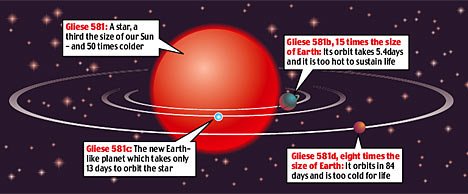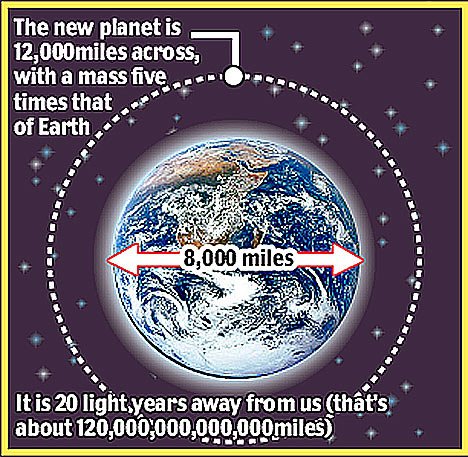Philosopher
Account Disabled
- Messages
- 534
- Reaction score
- 36


It's got the same climate as Earth, plus water and gravity. A newly discovered planet is the most stunning evidence that life - just like us - might be out there.
Above a calm, dark ocean, a huge, bloated red sun rises in the sky - a full ten times the size of our Sun as seen from Earth. Small waves lap at a sandy shore and on the beach, something stirs...
This is the scene - or may be the scene - on what is possibly the most extraordinary world to have been discovered by astronomers: the first truly Earth-like planet to have been found outside our Solar System.
The discovery was announced today by a team of European astronomers, using a telescope in La Silla in the Chilean Andes.
The Earth-like planet that could be covered in oceans and may support life is 20.5 light years away, and has the right temperature to allow liquid water on its surface.
This remarkable discovery appears to confirm the suspicions of most astronomers that the universe is swarming with Earth-like worlds.
We don't yet know much about this planet, but scientists believe that it may be the best candidate so far for supporting extraterrestrial life.
The new planet, which orbits a small, red star called Gliese 581, is about one-and-a-half times the diameter of the Earth.
It probably has a substantial atmosphere and may be covered with large amounts of water - necessary for life to evolve - and, most importantly, temperatures are very similar to those on our world.
It is the first exoplanet (a planet orbiting a star other than our own Sun) that is anything like our Earth.
Of the 220 or so exoplanets found to date, most have either been too big, made of gas rather than solid material, far too hot, or far too cold for life to survive.
"On the treasure map of the Universe, one would be tempted to mark this planet with an X," says Xavier Delfosse, one of the scientists who discovered the planet.
"Because of its temperature and relative proximity, this planet will most probably be a very important target of the future space missions dedicated to the search for extraterrestrial life."
Gliese 581 is among the closest stars to us, just 20.5 light years away (about 120 trillion miles) in the constellation Libra. It is so dim it can be seen only with a good telescope.
Because all planets are relatively so small and the light they give off so faint compared to their sun, finding exoplanets is extremely difficult unless they are huge.
Those that have so far been detected have mostly been massive, Jupiter-like balls of gas that almost certainly cannot be home to life.
This new planet - known for the time being as Gliese 581c - is a midget in comparison, being about 12,000 miles across (Earth is a little under 8,000 pole-to-pole).
It has a mass five times that of Earth, probably made of the same sort of rock as makes up our world and with enough gravity to hold a substantial atmosphere.
Astrobiologists - scientists who study the possibility of alien life - refer to a climate known as the Goldilocks Zone, where it is not so cold that water freezes and not so hot that it boils, but where it can lie on the planet's surface as a liquid.
In our solar system, only one planet - Earth -lies in the Goldilocks Zone. Venus is far too hot and Mars is just too cold. This new planet lies bang in the middle of the zone, with average surface temperatures estimated to be between zero and 40c (32-102f). Lakes, rivers and even oceans are possible.
It is not clear what this planet is made of. If it is rock, like the Earth, then its surface may be land, or a combination of land and ocean.
Another possibility is that Gliese 581c was formed mostly from ice far from the star (ice is a very common substance in the Universe), and moved to the close orbit it inhabits today.
In which case its entire surface will have melted to form a giant, planet-wide ocean with no land, save perhaps a few rocky islands or icebergs.
The surface gravity is probably around twice that of the Earth and the atmosphere could be similar to ours.
Although the new planet is in itself very Earth-like, its solar system is about as alien as could be imagined. The star at the centre - Gliese 581 - is small and dim, only about a third the size of our Sun and about 50 times cooler.
The two other planets are huge, Neptune-sized worlds called Gliese 581b and d (there is no "a", to avoid confusion with the star itself).
The Earth-like planet orbits its sun at a distance of only six million miles or so (our Sun is 93 million miles away), travelling so fast that its "year" only lasts 13 of our days.
The parent star would dominate the view from the surface - a huge red ball of fire that must be a spectacular sight.
It is difficult to speculate what - if any - life there is on the planet. If there is life there it would have to cope with the higher gravity and solar radiation from its sun.
Just because Gliese 581c is habitable does not mean that it is inhabited, but we do know its sun is an ancient star - in fact, it is one of the oldest stars in the galaxy, and extremely stable. If there is life, it has had many billions of years to evolve.
This makes this planet a prime target in the search for life. According to Seth Shostak, of the Search for Extraterrestrial Intelligence Institute in California, the Gliese system is now a prime target for a radio search. 'We had actually looked at this system before but only for a few minutes. We heard nothing, but now we must look again.'
By 2020 at least one space telescope should be in orbit, with the capability of detecting signs of life on planets orbiting nearby stars. If oxygen or methane (tell-tale biological gases) are found in Gliese 581c's atmosphere, this would be good circumstantial evidence for life.
Dr Malcolm Fridlund, a European Space Agency scientist, said the discovery of Gliese 581c was "an important step" on the road to finding life.
"If this is a rocky planet, it's very likely it will have liquid water on its surface, which means there may also be life."
The real importance is not so much the discovery of this planet itself, but the fact that it shows that Earth-like planets are probably extremely common in the Universe.
There are 200 billion stars in our galaxy alone and many astronomers believe most of these stars have planets.
The fact that almost as soon as we have built a telescope capable of detecting small, earth-like worlds, one turns up right on our cosmic doorstep, shows that statistically, there are probably billions of earths out there.
As Seth Shostak says: "We've never found one close to being like the Earth until now. We are finding that Earth is not such an unusual puppy in the litter of planets."
But are these alien Earths home to life? No one knows. We don't understand how life began on our world, let alone how it could arise anywhere else. There may be an awful lot of bugs and bacteria out there, and only a few worlds with what we would recognise as plants and animals. Or, of course, there may be nothing.
The Search for Extraterrestrial Intelligence Institute uses radio telescopes to try to pick up messages sent by alien civilisations.
Interestingly, Gliese 581c is so close to the Earth that if its putative inhabitants only had our level of technology, they could - just about - pick up some of our radio signals, such as the most powerful military transmitters. Quite what would happen if we for our part did receive a signal is unclear.
"There is a protocol, buried away in the United Nations," says Dr Shostak. "The President would be told first, after the signal was confirmed by other observatories. But we couldn't keep such a discovery secret."
It may be some time before we detect any such signals, but it is just possible that today we are closer than ever to finding life in the stars.
